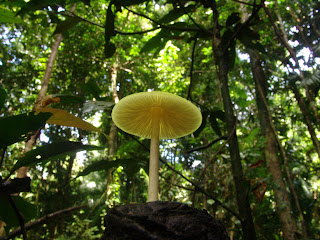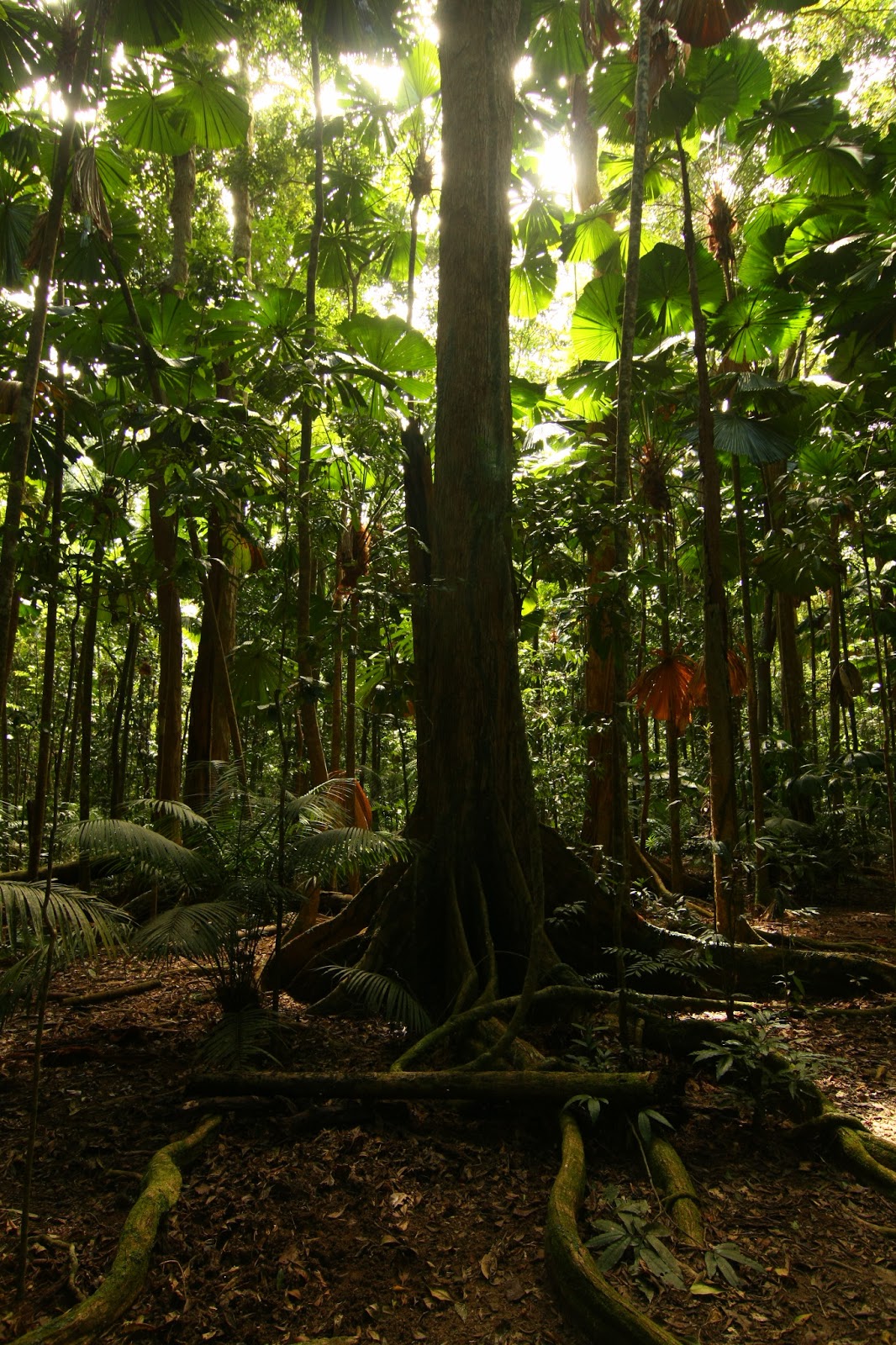Interdependence
Interdependence
In reality, what we have here is not three different systems at all. Rather, what we have is three parts of one system. If fact, this is just a one example of what we now know to be a fundamental feature of the natural world. It applies to every living system regardless of scale---, from the microscopic to the global.
The
Daintree Coast in Far North Queensland is a very popular tourist
destination which is marketed to the world by virtue of its diverse
natural landscape.
The
world famous Great Barrier Reef lies just off shore. Ranked amongst the
most biodiverse regions on the planet, The Reef is World Heritage
listed and the economic backbone of numerous communities, it is also
threatened with imminent destruction on multiple fronts. Adjacent the
Reef and also Heritage listed, the Daintree Rainforest is widely
considered to be the most ancient rainforest on Earth. Also ranked
amongst the most biodiverse ecosystems known,
the Daintree Rainforest is the last fragment of the ancient Gondwanan
rainforests from which Earths great modern rainforests have evolved.
Between the rainforest and the reef, growing along the rivers and
estuaries in the region, resides the most diverse mangrove on the
planet, with more than two thirds of the total diversity of mangrove
trees known to man.

What the casual visitor is seldom made aware of is that these three systems are intimately and inseparably interconnected.
Events
within one system affect the others in ways that we are only now
starting to appreciate. The more we find out, the more we discover that
the interdependence we observe in this living laboratory is just an
especially vivid example of some stunning ideas that are forcing us to revise what we think we know about how our world works.
As we pass the numerous lookouts along the coast which reveal all three systems in spectacular, panoramic detail, it's worth reflecting on this World Class example of the interconnectedness we now know is a defining feature of our living planet. Permit me to explain.
As we pass the numerous lookouts along the coast which reveal all three systems in spectacular, panoramic detail, it's worth reflecting on this World Class example of the interconnectedness we now know is a defining feature of our living planet. Permit me to explain.
The
Great Barrier Reef requires certain nutrients that originate on the
land. They start out in the costal forests in the form of organic
debris which gets flushed out of the forests when it rains. But if lots
of leaf litter made it all the way out to the reef, the reef would end
up blanketed by a fibrous sludge of rotting vegetation.
This would be a problem.
Apart
from the obvious impact of being buried by the debris, the tons of
detritus decomposing in the ocean would release a rich organic chemistry
over the reef. This would have a direct, chemical impact on the reef
and could also fuel algal blooms which would seriously reduce the
amount of light getting to the coral. So the reef does not need direct
rainforest run-off. It needs filtered rainforest nutrients.
This is where the mangroves come in.
The
mangroves are the filter. The dense, semi-submerged bank-side
vegetation acts as a very efficient filter, trapping the floating
detritus and keeping it there as it breaks down in the rivers and
estuaries. By the time the river empties out to sea, it contains the
right balance of chemicals for the Reef's requirements.
There is another, less obvious way in which the Mangroves manage the Reef's diet.
There is another, less obvious way in which the Mangroves manage the Reef's diet.
A
great number of creatures from the Reef begin life in the well
protected and nutrient rich environment of the mangroves. They are the
perfect nursery. In fact the fishing industry refers to mangroves as
nurseries.
Many
of the creatures from the reef, and from either side of the reef,
start their lives in the coastal mangrove forests. Upon maturity, these
young sea creatures migrate out to the reef, carrying with them the
rainforest nutrients that they built their bodies with during the
mangrove phase of their lives.
In
this sense, the mangroves are a factory; tasked with the conversion of
rainforest detritus into self-guided, reef-bound nutrient packages
called sea-life.
Of course, it goes a lot further than that.
As
much as the reef relies on these coastal forest ecosystems, without
the reef there would probably be no mangroves or rainforest on the
Daintree coast.
The Pacific Ocean is a very poorly named body of water. The "Pacific" is usually anything but.
Mangroves
can’t establish in crashing surf, and rainforest needs to keep very
tight control over its internal climatic conditions which would be
impossible in the face of constant oceanic weather conditions.
The
reef forms an obvious physical barrier against the Pacific swell,
which makes this coast very bad for surfing but perfect for mangroves.
As
for the weather, although the reef is under water, it still has an
enormous effect on the atmosphere above it. Between the reef and the
coast there is a large body of water that is trapped by the reef over a
shallow sandy seabed. This shallow, sandy, tropical sea warms up and
evaporates, creating a huge wall of hot, wet air that sits just off the
coast and acts as a barrier, or a buffer, against the weather coming
in from the Pacific. This ‘weather-wall’ protects the coast but as it
does so it is blown into the coast by the very weather it is protecting
us from. As this warm wet air gets forced over the mountains, it
experiences a pressure change and a temperature change which condenses
the water in the air onto water hungry organic molecules coating the
leaves and bark and expressed into the air by the forest.
The water dissolved in the air, the saturation of which we call
humidity, remains disolved unless it encounters a surface of appropriate
chemistry to settle on. Water loving chemical surfaces on leaves and on
the microscopic aerosols generated by plants, strip the moisture from
the very air itself, clawing it out of the sky and sending it down the
eastern slopes and out to sea instead of being blown over the hill and
lost to the Rainforest.
We now know that this is not the only method by which the Reef "waters" the Daintree Rainforest. It is now clear that coral reef is capable of creating clouds in the sky above it to protect itself from the sun. You read correctly, research on the GBR has demonstrated the ability of coral reefs, as communities, to literally generate clouds in the sky above them using an ingenious chemical trick to dim the harmful rays of the mid-day sun during the hottest time of the year.
Here's how it seems to work; Due to the emission of a gas, Dimethyl Sulphide or DMS, by the coral's algal symbiont, the air above a reef becomes rich in sulphurous airborne particles which have a strong attraction for water. The water in the air quickly forms droplets around these microscopic cloud-seeds. This process of condensation releases heat which warms the air, causing it to rise. The rising air carries the droplets upward and fresh air is sucked in to replace that which has just risen. The fresh air picks up more and more DMS as it rapidly diffuses into the air from the water below. Soon, strong, condensation powered thermals begin lifting tons of water into the airspace above the reef. By mid-day the clouds have formed and the reef is spared the worst of the mutagenic attention of the tropical summer sun. These are truely biogenic clouds; weather created directly and for selfish purposes by a biological process. This is not an isolated example of this sort of phenomenon and it changes the way we now think about weather. These clouds, in due course, float into the hills of the Great Dividing Range and make their contribution to the hydrological budget of the costal rainforests. These processes lift unimaginable tonnages of water out of the Coral Sea and then sponge the water out of the air and onto the Rainforest. If you don’t get rain, you don’t get rainforest. Nor do you get rainforest nutrients being flushed out of the forests, through the mangroves and out to the reef and so on…
We now know that this is not the only method by which the Reef "waters" the Daintree Rainforest. It is now clear that coral reef is capable of creating clouds in the sky above it to protect itself from the sun. You read correctly, research on the GBR has demonstrated the ability of coral reefs, as communities, to literally generate clouds in the sky above them using an ingenious chemical trick to dim the harmful rays of the mid-day sun during the hottest time of the year.
Here's how it seems to work; Due to the emission of a gas, Dimethyl Sulphide or DMS, by the coral's algal symbiont, the air above a reef becomes rich in sulphurous airborne particles which have a strong attraction for water. The water in the air quickly forms droplets around these microscopic cloud-seeds. This process of condensation releases heat which warms the air, causing it to rise. The rising air carries the droplets upward and fresh air is sucked in to replace that which has just risen. The fresh air picks up more and more DMS as it rapidly diffuses into the air from the water below. Soon, strong, condensation powered thermals begin lifting tons of water into the airspace above the reef. By mid-day the clouds have formed and the reef is spared the worst of the mutagenic attention of the tropical summer sun. These are truely biogenic clouds; weather created directly and for selfish purposes by a biological process. This is not an isolated example of this sort of phenomenon and it changes the way we now think about weather. These clouds, in due course, float into the hills of the Great Dividing Range and make their contribution to the hydrological budget of the costal rainforests. These processes lift unimaginable tonnages of water out of the Coral Sea and then sponge the water out of the air and onto the Rainforest. If you don’t get rain, you don’t get rainforest. Nor do you get rainforest nutrients being flushed out of the forests, through the mangroves and out to the reef and so on…
In reality, what we have here is not three different systems at all. Rather, what we have is three parts of one system. If fact, this is just a one example of what we now know to be a fundamental feature of the natural world. It applies to every living system regardless of scale---, from the microscopic to the global.
It seems that there is not a living system on this planet that exists independently of all others.


Comments